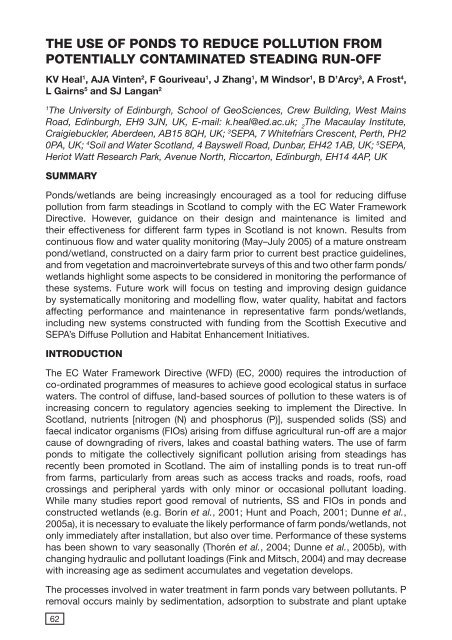Download as a PDF - CiteSeerX
Download as a PDF - CiteSeerX
Download as a PDF - CiteSeerX
Create successful ePaper yourself
Turn your PDF publications into a flip-book with our unique Google optimized e-Paper software.
THE USE OF PONDS TO REDUCE POLLUTION FROM<br />
POTENTIALLY CONTAMINATED STEADING RUN-OFF<br />
KV Heal 1 , AJA Vinten 2 , F Gouriveau 1 , J Zhang 1 , M Windsor 1 , B D’Arcy 3 , A Frost 4 ,<br />
L Gairns 5 and SJ Langan 2<br />
1<br />
The University of Edinburgh, School of GeoSciences, Crew Building, West Mains<br />
Road, Edinburgh, EH9 3JN, UK, E-mail: k.heal@ed.ac.uk; 2<br />
The Macaulay Institute,<br />
Craigiebuckler, Aberdeen, AB15 8QH, UK; 3 SEPA, 7 Whitefriars Crescent, Perth, PH2<br />
0PA, UK; 4 Soil and Water Scotland, 4 Bayswell Road, Dunbar, EH42 1AB, UK; 5 SEPA,<br />
Heriot Watt Research Park, Avenue North, Riccarton, Edinburgh, EH14 4AP, UK<br />
SUMMARY<br />
Ponds/wetlands are being incre<strong>as</strong>ingly encouraged <strong>as</strong> a tool for reducing diffuse<br />
pollution from farm steadings in Scotland to comply with the EC Water Framework<br />
Directive. However, guidance on their design and maintenance is limited and<br />
their effectiveness for different farm types in Scotland is not known. Results from<br />
continuous flow and water quality monitoring (May–July 2005) of a mature onstream<br />
pond/wetland, constructed on a dairy farm prior to current best practice guidelines,<br />
and from vegetation and macroinvertebrate surveys of this and two other farm ponds/<br />
wetlands highlight some <strong>as</strong>pects to be considered in monitoring the performance of<br />
these systems. Future work will focus on testing and improving design guidance<br />
by systematically monitoring and modelling flow, water quality, habitat and factors<br />
affecting performance and maintenance in representative farm ponds/wetlands,<br />
including new systems constructed with funding from the Scottish Executive and<br />
SEPA’s Diffuse Pollution and Habitat Enhancement Initiatives.<br />
INTRODUCTION<br />
The EC Water Framework Directive (WFD) (EC, 2000) requires the introduction of<br />
co-ordinated programmes of me<strong>as</strong>ures to achieve good ecological status in surface<br />
waters. The control of diffuse, land-b<strong>as</strong>ed sources of pollution to these waters is of<br />
incre<strong>as</strong>ing concern to regulatory agencies seeking to implement the Directive. In<br />
Scotland, nutrients [nitrogen (N) and phosphorus (P)], suspended solids (SS) and<br />
faecal indicator organisms (FIOs) arising from diffuse agricultural run-off are a major<br />
cause of downgrading of rivers, lakes and co<strong>as</strong>tal bathing waters. The use of farm<br />
ponds to mitigate the collectively significant pollution arising from steadings h<strong>as</strong><br />
recently been promoted in Scotland. The aim of installing ponds is to treat run-off<br />
from farms, particularly from are<strong>as</strong> such <strong>as</strong> access tracks and roads, roofs, road<br />
crossings and peripheral yards with only minor or occ<strong>as</strong>ional pollutant loading.<br />
While many studies report good removal of nutrients, SS and FIOs in ponds and<br />
constructed wetlands (e.g. Borin et al., 2001; Hunt and Poach, 2001; Dunne et al.,<br />
2005a), it is necessary to evaluate the likely performance of farm ponds/wetlands, not<br />
only immediately after installation, but also over time. Performance of these systems<br />
h<strong>as</strong> been shown to vary se<strong>as</strong>onally (Thorén et al., 2004; Dunne et al., 2005b), with<br />
changing hydraulic and pollutant loadings (Fink and Mitsch, 2004) and may decre<strong>as</strong>e<br />
with incre<strong>as</strong>ing age <strong>as</strong> sediment accumulates and vegetation develops.<br />
The processes involved in water treatment in farm ponds vary between pollutants. P<br />
removal occurs mainly by sedimentation, adsorption to substrate and plant uptake<br />
62

















